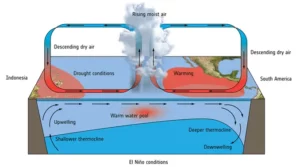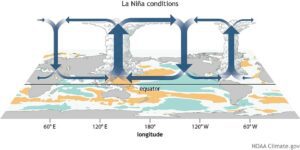El Niño and La Niña
#GS-01 Geography
For Prelims:
- El Niño and La Niña are opposite phases of what is known as the El Niño-Southern Oscillation (ENSO) cycle.
El Niño:
- El Nino means ‘little boy’ or ‘Christ child’ in Spanish.
- El Nino is a climate pattern that describes the unusual warming of surface waters in the eastern tropical Pacific Ocean along the coast of Ecuador and Peru.
- It is the “warm phase” of a larger phenomenon called the El Nino-Southern Oscillation (ENSO).
- The El Nino event is not a regular cycle, they are not predictable and occur irregularly at two- to seven-year intervals.
- El Niño normally occurs around Christmas and usually lasts for a few weeks to a few months.
- Sometimes an extremely warm event can develop that lasts for much longer time periods.
- In the 1990s, strong El Niños developed in 1991 and lasted until 1995, and from fall 1997 to spring 1998.
- It occurs more frequently than La Nina.
Impact of El Nino:
- El Nino and Indian monsoon are inversely related.
- The cool surface water off the Peruvian coast goes warm because of El Nino.
- When the water is warm, the normal trade winds get lost or reverse their direction.
- Hence, the flow of moisture-laden winds is directed towards the coast of Peru from the western Pacific (the region near northern Australia and South East Asia).
- This causes heavy rains in Peru during the El Nino years robbing the Indian subcontinent of its normal monsoon rains.
- The larger the temperature and pressure difference, the larger the rainfall shortage in India.
La Niña:
- La Nina means ‘little girl’ in Spanish and is also known as El Viejo or ‘cold event’.
- La Nina, the “cool phase” of ENSO, is a pattern that describes the unusual cooling of the tropical eastern Pacific.
- La Nina events may last between one and three years, unlike El Nino, which usually lasts no more than a year.
Impact of La Nina:
- La Nina is caused by a build-up of cooler-than-normal waters in the tropical Pacific, the area of the Pacific Ocean between the Tropic of Cancer and the Tropic of Capricorn.
- La Nina events are also associated with rainier-than-normal conditions over southeastern Africa and northern Brazil.
- However, strong La Nina events are associated with catastrophic floods in northern Australia.
- Drier-than-normal conditions are observed along the west coast of tropical South America, the Gulf Coast of the United States, and the pampas region of southern South America.






